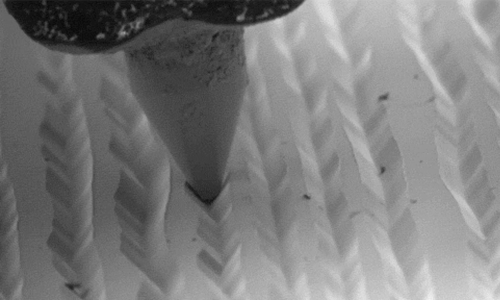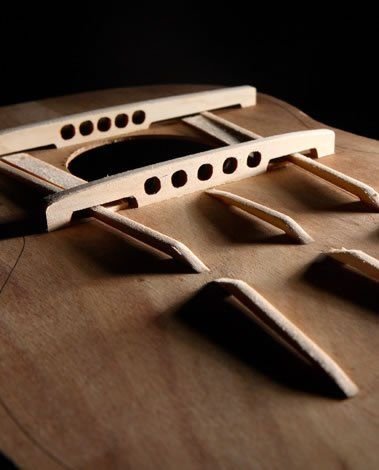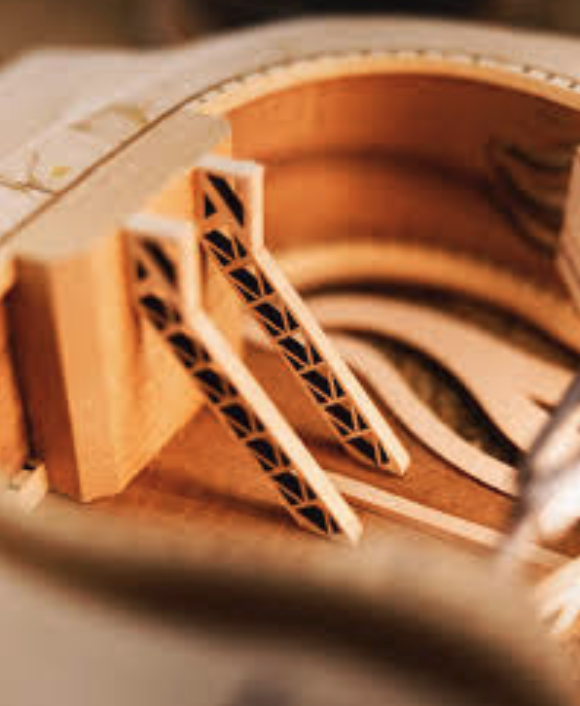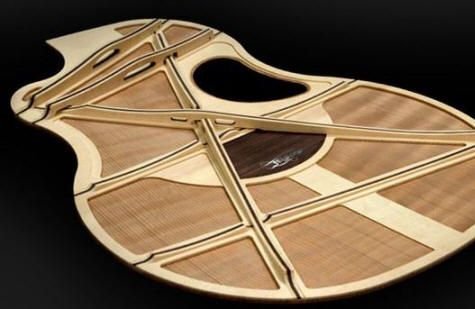it also expands and contracts considerably, and could set up ugly resonances. If you're looking to replace/reinforce wood on a musical instrument, I would think composites would be the way to go, and have the advantage of consistency, assuming it was dialed in properly before production.Metal gets heavy, quickly
You are using an out of date browser. It may not display this or other websites correctly.
You should upgrade or use an alternative browser.
You should upgrade or use an alternative browser.
Martin's "skeletonized" bracing system
- Thread starter GGJaguar
- Start date
RBSinTo
Senior Member
- Joined
- Jul 13, 2021
- Messages
- 1,176
- Reaction score
- 1,499
- Guild Total
- 1
I wonder if there would be as many naysayers' comments about this change in bracing if it had been announced by Guild instead of Martin?
RBSinTo
RBSinTo
JohnW63
Enlightened Member
3d printed braces , next?
I'm all for trying new things, if it works over the long haul. You know me, the Ovation guy. I never got to play the Ovation with X bracing, but I would still like to.
I'm all for trying new things, if it works over the long haul. You know me, the Ovation guy. I never got to play the Ovation with X bracing, but I would still like to.
Yup, caught that, Boneman. It's not really explained, but supposedly these are being grooved for tone. Hmm...the grooves are explained, talk about the top starting at about 6 minutes
GGJaguar
Reverential Member
Yes... and...Yup, caught that, Boneman. It's not really explained, but supposedly these are being grooved for tone. Hmm...
For years it has been established that a soundboard must be strong enough to withstand the pull of the strings, and be supple enough to move in response to the string energy. Putting the relationship between the two goals into practice, and finding that balance, is the "secret sauce" employed by luthiers everywhere.
Martin, like many others, is removing soundboard material directly beneath the bracing, excess material that is deemed to be unnecessary. The braces are sufficient to strengthen the soundboard; the entire soundboard does not need to be as thick as was once thought in order to have inherent strength. If you were to remove the bracing then, by yesteryear's understandings, such a "grooved/groovy" soundboard would be deemed insufficiently strong enough to withstand the forces that will be applied.
From listening to the tone this guitar has, I'm not particularly impressed : it sounds okay, but like many others do...The tone seems a bit "thick", a little muffled, missing some articulation and dynamic variations or nuances it seemed to me...
But I'll have to wait till one of the better guitar reviewers plays it to know more...
Maybe too, will it take a bit more time for people to understand how to make he best out of it...
It may have been designed as an acoustic-electric rather than a genuine acoustic too.
It is a part of a larger move towards using domestic woods : mahogany has become expensive, and rosewood probably a bit harder to find too...Builders are trying to make other woods sound more like them, through bracing improvements. Taylor has been doing that for quite a while too with maple on the 600 series.
It would be nice to be able to play one to see how it feels : retailers and builders would always tell it's great anyhow
But I'll have to wait till one of the better guitar reviewers plays it to know more...
Maybe too, will it take a bit more time for people to understand how to make he best out of it...
It may have been designed as an acoustic-electric rather than a genuine acoustic too.
It is a part of a larger move towards using domestic woods : mahogany has become expensive, and rosewood probably a bit harder to find too...Builders are trying to make other woods sound more like them, through bracing improvements. Taylor has been doing that for quite a while too with maple on the 600 series.
It would be nice to be able to play one to see how it feels : retailers and builders would always tell it's great anyhow
steve488
Member
With referencing those channels, it seems to me that Taylor was doing that at one time on some of their models. There was a channel cut just inside the perimeter with the thought that it allowed the top to vibrate better (not sure what better meant). Martins version seems to me to have created several different areas wherein the harmonics and frequency variations might create some interesting variations in the tonal response. .... but maybe not.
amnicon
Member
- Joined
- May 3, 2009
- Messages
- 361
- Reaction score
- 159
- Guild Total
- 6
Torrefaction, "channeling", certifying, 'sustainabling'  , skeletonizing, where are Guild these days ? Loosing time in modern guitar conception, or remaining wise and deep, attached to genuine values rather than mere non lasting trends ?
, skeletonizing, where are Guild these days ? Loosing time in modern guitar conception, or remaining wise and deep, attached to genuine values rather than mere non lasting trends ?
Isn't that changing owners every now and then, will make them late in the long run soon ; what do you think LTGers ?
Isn't that changing owners every now and then, will make them late in the long run soon ; what do you think LTGers ?
Charlie Bernstein
Senior Member
The guitar might weigh less, but that's not why they're doing it. The new braces increase both loudness and sustain.I don't know how much weight they are actually saving in the braces. They look taller than usual and could weigh nearly the same, if not more.
There are other ways to increase one at the expense of the other. This way, they're doing both — a two-fer.
davenumber2
Member
Yamaha has their own torrefaction process (ARE). Maybe they’ll transfer that onto some Guilds.Torrefaction, "channeling", certifying, 'sustainabling', skeletonizing, where are Guild these days ? Loosing time in modern guitar conception, or remaining wise and deep, attached to genuine values rather than mere non lasting trends ?
Isn't that changing owners every now and then, will make them late in the long run soon ; what do you think LTGers ?
The Carbon fibre thing sure seems to work as a stiffener for the neck. I remember when I first bought my 2010 F512, and it arrived with high action. When I picked it up from my luthier, I was crestfallen when there wasn't much saddle left. That was 11 years ago now, and the relief on the neck, and the action, hasn't changed even the tiniest bit.Laminated wood braces (using woods from two or more species, such as Spruce/Rosewood/Spruce), as well as Wood and Carbon Fiber laminated braces have been used for some time, now. Metal gets heavy, quickly, and all-carbon bracing is extremely costly, and the fact that the latter results in a "brittle" sounding instrument is considered less than desirable by more than a few. Currently, it is popular to fashion a slightly-smaller-than-normal wood brace, then glue strands of carbon fiber (called "tow") between the brace and soundboard, as well as across the exposed top of the braces, after they are shaped. This dramatically stiffens the overall brace, while reducing the overall weight. And that's just one way, another way, to accomplish the task.
SFIV1967
Venerated Member
There are all kind of such interesting bracings around.Laminated wood braces (using woods from two or more species, such as Spruce/Rosewood/Spruce), as well as Wood and Carbon Fiber laminated braces have been used for some time, now.
I liked the pure look of the McPherson overpass/underpass bracing:
"The unique Overpass/Underpass Bracing System also creates a larger, more even space for the top to vibrate. The soundboard’s braces cross each other but never touch or inhibit vibration. This frees the braces to vibrate independently while still lending structural support and maximizing soundboard vibration and resonance."

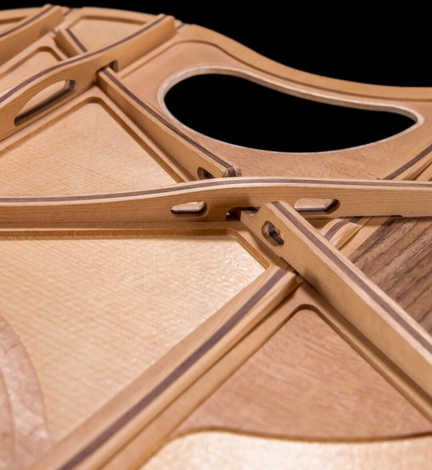
Or this "T-Beam" back bracing from Charis Acoustic. Also he is using interesting kerfings.
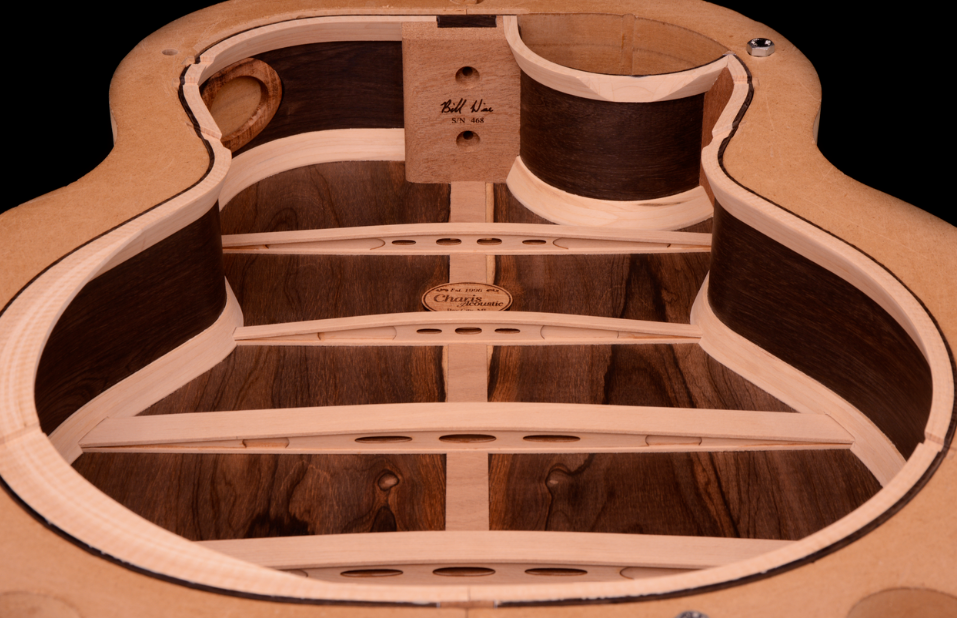
Ralf
By the way, I looked closer at those Martin braces and they actually look like multilayer laminates not solid wood. Interesting. Maybe with CF?The guitar might weigh less, but that's not why they're doing it. The new braces increase both loudness and sustain.
There are other ways to increase one at the expense of the other. This way, they're doing both — a two-fer.
davenumber2
Member
Fender does this same thing. They put out this "new" thing that modders (luthiers in this case) have been doing for years and call it revolutionary. Like a few years ago they came out with a line of teles with p90's in the neck. Oh what an idea.
AcornHouse
Venerated Member
One thing that the underpass part of the cross fails at, is that by not having any connection above, you essentially lose more than have of the strength right at the middle. Ask any good plumber/framer and they'll tell you that it's ok to put a pipe through the middle of a beam, but if you cut a notch down to the pipe, you compromise the strength of the beam. That's why, thanks to the research of Somogyi, I, and many other small builders, glue a bridge over the x brace that's notched in the top half. It adds that strength back.
And Martin's traditional cloth patch, which they're using in their new Hi-Tech approach, doesn't really do much in that regard.
merlin6666
Senior Member
Nice to see that Martin is trying to do something innovative and not just capitalize on laurels of past centuries.
Of course, a McPherson guitar isn't also missing 12.5 squared inches of structural soundboard directly in front of that "X", as is the case with a center soundhole instrument. By moving the soundhole off to one side, Matt was able to explore another approach, rather successfully.One thing that the underpass part of the cross fails at, is that by not having any connection above, you essentially lose more than have of the strength right at the middle.
